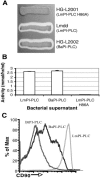Characterization of Listeria monocytogenes expressing anthrolysin O and phosphatidylinositol-specific phospholipase C from Bacillus anthracis
- PMID: 16177340
- PMCID: PMC1230906
- DOI: 10.1128/IAI.73.10.6639-6646.2005
Characterization of Listeria monocytogenes expressing anthrolysin O and phosphatidylinositol-specific phospholipase C from Bacillus anthracis
Abstract
Two virulence factors of Listeria monocytogenes, listeriolysin O (LLO) and phosphatidylinositol-specific phospholipase C (PI-PLC), mediate escape of this pathogen from the phagocytic vacuole of macrophages, thereby allowing the bacterium access to the host cell cytosol for growth and spread to neighboring cells. We characterized their orthologs from Bacillus anthracis by expressing them in L. monocytogenes and characterizing their contribution to bacterial intracellular growth and cell-to-cell spread. We generated a series of L. monocytogenes strains expressing B. anthracis anthrolysin O (ALO) and PI-PLC in place of LLO and L. monocytogenes PI-PLC, respectively. We found that ALO was active at both acidic and neutral pH and could functionally replace LLO in mediating escape from a primary vacuole; however, ALO exerted a toxic effect on the host cell by damaging the plasma membrane. B. anthracis PI-PLC, unlike the L. monocytogenes ortholog, had high activity on glycosylphosphatidylinositol-anchored proteins. L. monocytogenes expressing B. anthracis PI-PLC showed significantly decreased efficiencies of escape from a phagosome and in cell-to-cell spread. We further compared the level of cytotoxicity to host cells by using mutant strains expressing ALO in combination either with L. monocytogenes PI-PLC or with B. anthracis PI-PLC. The results demonstrated that the mutant strain expressing the combination of ALO and B. anthracis PI-PLC caused less damage to host cells than the strain expressing ALO and L. monocytogenes PI-PLC. The present study indicates that LLO and L. monocytogenes PI-PLC has adapted for L. monocytogenes intracellular growth and virulence and suggests that ALO and B. anthracis PI-PLC may have a role in B. anthracis pathogenesis.
Figures





Similar articles
-
Listeria monocytogenes listeriolysin O and phosphatidylinositol-specific phospholipase C affect adherence to epithelial cells.Can J Microbiol. 2005 Sep;51(9):745-51. doi: 10.1139/w05-058. Can J Microbiol. 2005. PMID: 16391652
-
Listeria monocytogenes phosphatidylinositol-specific phospholipase C has evolved for virulence by greatly reduced activity on GPI anchors.Proc Natl Acad Sci U S A. 2005 Sep 6;102(36):12927-31. doi: 10.1073/pnas.0501725102. Epub 2005 Aug 23. Proc Natl Acad Sci U S A. 2005. PMID: 16118276 Free PMC article.
-
Mobilization of protein kinase C in macrophages induced by Listeria monocytogenes affects its internalization and escape from the phagosome.Infect Immun. 2002 Aug;70(8):4650-60. doi: 10.1128/IAI.70.8.4650-4660.2002. Infect Immun. 2002. PMID: 12117979 Free PMC article.
-
Listeriolysin O: a phagosome-specific lysin.Microbes Infect. 2007 Aug;9(10):1176-87. doi: 10.1016/j.micinf.2007.05.005. Epub 2007 May 7. Microbes Infect. 2007. PMID: 17720603 Review.
-
Multifaceted activity of listeriolysin O, the cholesterol-dependent cytolysin of Listeria monocytogenes.Subcell Biochem. 2014;80:161-95. doi: 10.1007/978-94-017-8881-6_9. Subcell Biochem. 2014. PMID: 24798012 Free PMC article. Review.
Cited by
-
Carboxyl-Terminal Residues N478 and V479 Required for the Cytolytic Activity of Listeriolysin O Play a Critical Role in Listeria monocytogenes Pathogenicity.Front Immunol. 2017 Nov 1;8:1439. doi: 10.3389/fimmu.2017.01439. eCollection 2017. Front Immunol. 2017. PMID: 29163512 Free PMC article.
-
Bacillus anthracis phospholipases C facilitate macrophage-associated growth and contribute to virulence in a murine model of inhalation anthrax.Infect Immun. 2006 Jul;74(7):3756-64. doi: 10.1128/IAI.00307-06. Infect Immun. 2006. PMID: 16790747 Free PMC article.
-
The Bacillus anthracis cholesterol-dependent cytolysin, Anthrolysin O, kills human neutrophils, monocytes and macrophages.BMC Microbiol. 2006 Jun 21;6:56. doi: 10.1186/1471-2180-6-56. BMC Microbiol. 2006. PMID: 16790055 Free PMC article.
-
Global analysis of community-associated methicillin-resistant Staphylococcus aureus exoproteins reveals molecules produced in vitro and during infection.Cell Microbiol. 2007 May;9(5):1172-90. doi: 10.1111/j.1462-5822.2006.00858.x. Epub 2007 Jan 9. Cell Microbiol. 2007. PMID: 17217429 Free PMC article.
-
Role of pore-forming toxins in bacterial infectious diseases.Microbiol Mol Biol Rev. 2013 Jun;77(2):173-207. doi: 10.1128/MMBR.00052-12. Microbiol Mol Biol Rev. 2013. PMID: 23699254 Free PMC article. Review.
References
-
- Bishop, D. K., and D. J. Hinrichs. 1987. Adoptive transfer of immunity to Listeria monocytogenes: the influence of in vitro stimulation on lymphocyte subset requirements. J. Immunol. 139:2005-2009. - PubMed
-
- Cataldi, A., E. Labruyere, and M. Mock. 1990. Construction and characterization of a protective antigen-deficient Bacillus anthracis strain. Mol. Microbiol. 4:1111-1117. - PubMed
-
- Chico-Calero, I., M. Suárez, B. González-Zorn, M. Scortti, J. Slaghuis, W. Goebel, J. A. Vázquez-Boland, et al. 2002. Hpt, a bacterial homolog of the microsomal glucose-6-phosphate translocase, mediates rapid intracellular proliferation in Listeria. Proc. Natl. Acad. Sci. USA 99:431-436. - PMC - PubMed
Publication types
MeSH terms
Substances
Grants and funding
LinkOut - more resources
Full Text Sources
Research Materials
Miscellaneous

